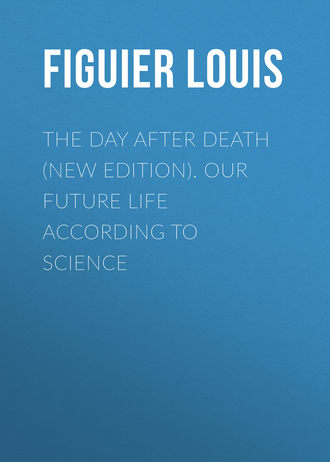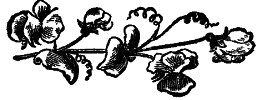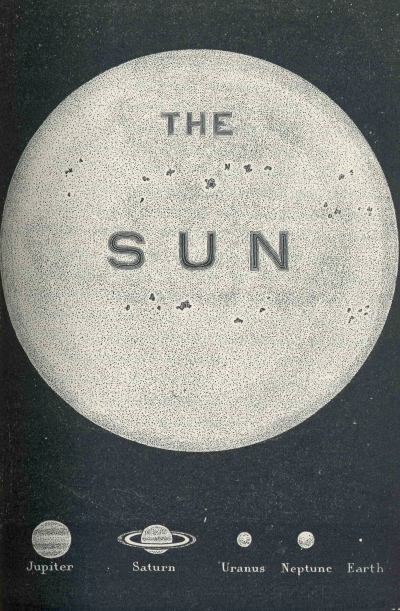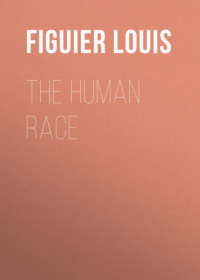 полная версия
полная версияThe Day After Death (New Edition). Our Future Life According to Science
Languages are only the expression and the assembling of ideas. Condorcet has said that a science always reduces itself to a well-constructed language. The mathematical sciences employ a language which is perfect, because the science of mathematics is perfect. The language spoken in the planetary spaces must be perfect, because it expresses all the knowledge of superhuman beings, and this knowledge is immense. The more the mind knows, the better it expresses:—the superhuman being, who is highly informed, will have a very expressive language, which will also be universal.
The language of mathematics is understood by the peoples of both hemispheres. Algebra can be read by a Frenchman or a German, as well as by an Australian or a Chinese, on account of the simplicity and perfection of the conventional signs which it uses. The language of mathematics, which is truly universal, makes us infer that the language spoken in the planetary space must be also universal, and common, without distinction, to all the inhabitants of the ethereal worlds.
Owing to the immense scope of their faculties, and to the perfection of their language, in itself a certain means of increasing and exalting their knowledge, superhuman beings have a power of reasoning, and a clearness of judgment, which, added to the immense number of facts stored in their memory, place them in possession of absolute science. Arduous questions, before which the mind of man humbly confesses its powerlessness, or which drive him mad if he persists in the effort to solve them, such as the thought of the Infinite, the idea of the First Cause of the Universe, the Essence of Divinity, all these problems, forbidden to us, are easily accessible to these mighty thinkers. He who is regarded by mankind as a genius of the first order, an Aristotle, a Keppler, a Newton, a Raphael, a Shakespeare, a Molière, a Mozart, a Lavoisier, a Laplace, a Cuvier, a Victor Hugo, would be among them a babbling child. No science, no moral idea is above their conception. Beneath their feet rolls the earth, with the splendid train of the planets, its sisters; they behold the planets of our solar system gravitating in harmonious order round the great central star, which deluges them with its light. From the height of their sublime abode they witness the infinitely various spectacles furnished by the elemental strife of our poor globe, and those which resemble it; and, happier than terrestrial humanity, they admire the works of God, while knowing the secret of their mechanism. In the moral order they have penetrated the great Wherefore! They know why man exists, and why they themselves exist. They know whence they come, and whither they are going; and we, alas! know neither. Where, to our eyes, there is only confusion, they perceive harmony and order. The designs of God are distinctly apparent to them, and also the events of the lives of nations and individuals, which often seem to us cruel, unjust, and bad on the part of God; but they understand that these events are just and useful, and worthy of our heartfelt gratitude.
We also think, that in the ethereal spaces time is an element which does not count. We believe this, because time does not exist for God, and all superhuman beings approach, by their perfections, the entirely spiritual nature, and consequently approach God. We are confirmed in this belief by the fact, that very profound grief resists time, that there is no limit in duration to the great blows struck at the human soul, that the loss of a beloved being is felt as keenly after a long interval as when he was taken away.
Thus, time, which is everything to man, which is not only, according to the English adage, "money," but is also the instrument of our wisdom, our studies, and our attainments—far otherwise precious than money—time does not count in the life of the superhuman being. He awaits, without impatience and without suffering, the arrival of the beings whom he has loved and left upon the earth at his peaceful abode; and when their re-union takes place, he and they enjoy happiness which no inquietude concerning the future can ever trouble. Enabled to despise, to put aside the idea of time, the superhuman being looks on with unutterable serenity, tranquillity, and majesty, at the majestic spectacle, always new and always marvellous, of the revolutions of the stars, and the great movements of the universe.
The Life of the Superhuman Being.—In completion of our speculation upon the attributes of the superhuman being, we shall consider the life which animates him and gives his body its active qualities.
We have said that, in our belief, the superhuman being proceeds from the soul of a man which has domiciled itself afresh, in a new body, in the bosom of the world of ether. Is this body destined, at the end of a more or less prolonged period to perish, to be dissolved, to restore its elements to matter, as they are restored by the human body? Shall life be withdrawn from the body of the superhuman being, and shall the soul take flight thence?
We believe that it will be so. Life everywhere implies death, and is its necessary term. We do not cast anchor in the current of the waters of life. If the soul of the superhuman being resides in a living body, this body must die, and its material elements must return to the common reservoir of nature. The torch of life is extinguished in the spaces, as it is extinguished upon earth.
We believe the superhuman being to be mortal. After an interval, whose duration we shall not attempt to fix, he dies; and the soul which dwelt within him escapes, like a sweet perfume from a broken vase. What becomes of the soul which has torn itself away from the body, cold in death? We shall seek after the answer to this question in our next chapter.


CHAPTER THE SIXTH
WHAT BECOMES OF THE SUPERHUMAN BEING AFTER DEATH?—DEATHS, RESURRECTIONS, AND NEW INCARNATIONS IN THE ETHEREAL SPACESIN the living nature which surrounds us, there is a continually ascending scale of gradual perfection, from the plant to man. Taking mosses and algæ, which represent the rudimentary condition of vegetable organization, as our point of departure, we pass on through the whole series of the perfecting processes of the vegetable kingdom, and we reach the inferior animals, zoophytes and mollusca. From thence we ascend to the superior animals by insensible degrees, and thus fully attain to man. Each step of this ladder is almost imperceptible, so finely arranged are the transitions and the shades; so that there is a really infinite chain of intermediate beings, at one end of which are the algæ, and at the other ourselves. And yet we think it possible that between us and God there should be no kind of intermediate being! that in this scale of continual progress, there should be an immense void between man and the Creator! We think it possible that all nature, from the lowest vegetable to mankind, should be arranged in successive and innumerable degrees, and that between man and God there should exist only a desert, an immeasurable hiatus. Evidently, this is impossible, and that such an error should ever have been countenanced by religion and philosophy is only to be explained by ignorance of natural phenomena. It is impossible to doubt that between man and God, as between the plant and the animal, the animal and man, there exist a great number of intermediate creations, which establish the transition of humanity into the divinity which governs it, in infinite power and majesty.
That these intermediate beings exist, we are certain. They are invisible to us, but, if we refused to admit the existence of everything which we cannot see, we should be very easily refuted. Let a naturalist take a drop of water from a pond, and, shewing it to an ignorant person, tell him, "this drop of water, in which you do not see anything, is filled with little animals, and with miniature plants, which live, are born and die, like the animals and plants, which inhabit our farms." The ignorant person would probably shrug up his shoulders, and consider the speaker crazy. But if he were induced to apply his eye to the magnifier of a microscope, in order to examine the contents of the drop of water, he must acknowledge that the truth had been told him; because, in this drop of water, in which he could at first see nothing, his eye, when assisted by science, would discern whole worlds.
A great number of living beings can therefore exist where we see nothing, and it is feasible to science to open the eyes of the multitude in this respect.
We desire to assume the position of the naturalist of whom we have spoken. Between man and God, the ignorant crowd and a blind philosophy perceive nothing; but, when we replace the eyes of the body by those of the spirit, that is to say, when we make use of reason, analogy, and education, these mysterious beings come to light.
We have already, in studying the superhuman being, described one of those intermediate creations between man and the divinity, and defined the existence of one of those landmarks placed by nature on the high-road of infinite space. But the ladder does not break off at its first step, and we are convinced that numerous living hierarchies intervene between the superhuman being and the radiant throne of the Almighty. We have said elsewhere, that, in our belief, superhuman beings are mortal. What becomes of them after their death? Let us now take up the thread of our deductions.
We believe that—the superhuman being having died at the end of a term whose duration we have no means of knowing—his soul, perfected by the exercise of the new faculties which it has received, and the new senses with which it has been endowed, enters into a new body, provided with senses still more numerous and more exquisite, and endowed with faculties of still greater power, and thus commences a fresh existence.
We call the being who succeeds to man angel, or superhuman; we may call his succession in the ethereal realm, arch-angel, or arch-human.
The actual moment of the passage from one life to another, must be, as it is in the case of man, a time of moral and physical pain. The supreme periods at which a metamorphosis takes place in a sensible being are crises full of anguish and torment.
We will not endeavour to penetrate the secrets of the organization of the new being whose existence we thus trace, and who is superior to the superhuman being in the natural hierarchy; because our means of investigation fail us at this point. We have ventured to form some conjecture respecting the body, the soul, and the life of the superhuman being, because in that case, however adventurous our excursion into unknown spheres, we had a point of comparison and induction in the human species. But all induction respecting the arch-human being who succeeds the superhuman, is wanting, for we could only perceive the latter by means of conjectures and analogies which we must not carry farther.
We will, therefore, abstain from pursuing this kind of investigation, permitting the reader to exercise his own imagination upon the form of the body, the number and perfection of the senses, and the extent of the faculties of the happy creature who succeeds to the superhuman being, and who dwells, like him, in the immensity of ethereal space. We will only add that we do not think a second, a third, or a fourth incarnation arrests the succession of the chain of sublime creations, which float in the infinitude of the heavens, and which proceed from a primitive human soul, which has grown in perfection and in moral power. It surpasses our faculty to define, by the unassisted light of our reason and our knowledge, the number of these beings who go on succeeding one another in ever-increasing perfection. We can only say that we believe the creatures, which compose this ladder of perfections in succession, must be very numerous.
At every stage of his promotion in the hierarchy of nature the celestial being beholds the growth of those wings which symbolize his marvellous power to us. Each time his organs become more numerous, more flexible, have greater scope. He acquires new and exquisite senses. He acquires more and more power of extending his beneficent empire, of exercising his faculty of loving his fellows and all nature, and, above all, of comprehending and reading the designs of God. Deeper and deeper affections engage his soul, for the tenderness and the happiness engendered in its pure satisfaction, are granted to him to console him for the sufferings of death, to which he is always condemned. It is thus that the happiness of the elect is augmented. It is thus that the beings who inhabit the boundless plains of the invisible world employ each of their lives in preparing for the life which is to follow, in securing by a wise exercise of their freedom, industrious culture of their faculties, strict observance of morality, and continuous beneficence, a more noble, more animated, and happier destiny in the new spaces which await them, in the development of their sublime destiny.4
Nevertheless, as everything comes to an end in this world, so must everything have an end in the surrounding spheres. After having traversed the successive stages and rested in the successive stations of their journey through the skies, the beings whom we are considering must finally reach a defined place. What is this place, the ultimate term of their immense cycle across the spaces? In our belief, it is the sun.


CHAPTER THE SEVENTH
PHYSICAL AND GEOGRAPHICAL POSITION OF THE SUNACCORDING to our system of thought the sun is the central place in which souls which come from the ethereal spaces are finally gathered together. After having undergone the successive incarnations which we have described, souls, primitively human, finish by reaching the sun, by dwelling within the borders of the star-king.
This, then, is a fitting place for a description of the sun from the physical and astronomical point of view. Such a description will at once reveal the entirely sovereign part played by that globe which has no fellow. The astonishing attributes which belong to it, the unimaginable power which it wields, will sufficiently explain the place at the summit of the ascending scale of nature, which we assign to the sun.
In the first place, the sun is totally different from the other stars of our world. He resembles nothing, and nothing can be compared with him. Neither planets, satellites, asteroids, nor comets can give us any idea of him. His immense volume, his physical constitution, his exceptional properties place him in a totally separate rank, and afford full justification to those who claim for him a separate and sovereign place.
The enormous mass of the sun at once proclaims his supremacy. The sun is sufficiently vast to receive everything which could come to him from all the other planets. He surpasses in volume the united size of all the celestial bodies which revolve around him. He is six hundred times larger than the entire assemblage of the planets with their satellites, of the asteroids and the comets which compose what is called the solar world; that is to say, the world of which we form a part. The proportion in which the sun exceeds the earth in volume is, then, necessarily enormous; since he is larger than all the other stars put together. He is one million three hundred thousand times larger than our globe.
It is only by drawing that we can give an exact idea of the comparative sizes of the sun and the other planets. The reader will find in the accompanying illustration (Fig. 1) a figure which exactly represents the comparative dimensions of the sun, and the largest planets of our world. The earth, represented by a dot, gives an idea of what Mars, Mercury, and Venus, which are smaller than the earth, must be.
It takes three years to circumnavigate the earth. To circumnavigate the solar globe, under similar conditions, would take three hundred years. If human life be not more prolonged in the sun than on the earth, an existence would not suffice to enable a traveller to become acquainted with the surface of the globe he inhabits.

Fig. 1.—Comparative Dimensions of the Sun and the Planets.
Weight is thirty times more intense on the surface of the sun than on the earth. We know that a body which falls upon the earth traverses, in the first second of its fall, a space of four metres, nine centimetres. In the sun a falling body traverses 144 metres in the first second of its fall. It follows from this, that a human body, if transported to the sun, would weigh about 2000 kilogrammes, the weight of an elephant. The body of a dog or of a horse would weigh twenty-eight times as much as upon our earth, so that these animals would remain fixed to the surface. The conditions of nature must therefore be entirely different in the sun from what they are in the group of planets to which the earth belongs.
The sun sheds rays from perpetual fire, a characteristic that appertains to him alone among all the stars of our world. Of himself he burns, and sheds abroad light and heat. The other stars are neither warm nor luminous, and if the sun did not exist, they would be plunged into eternal darkness and eternal cold. This privilege alone ought to make us comprehend the immense importance of the central star.
The light and heat which emanate from the sun are constant; they are never interrupted, and they never lose their force. Thus, a second characteristic—constancy of illumination—separates the sun from all the other celestial bodies of our world.
The intensity of the real heat of the sun has been measured by the physicists. This result was attained in an endeavour to determine by experience the quantity of heat which accumulates in a given time, upon a certain portion of the earth's surface, exposed to the sun's rays, and adding to that element the quantities of heat which would be absorbed by the atmospheric air, the ethereal spaces, and the soil.
Pouillet, the French physicist, who undertook this critical investigation, arrived at certain results, which he states as follows:
"If the total quantity of heat emitted by the sun was exclusively employed to melt a layer of ice applied to the solar globe, and covering it completely in all its parts, that quantity of heat would be able to melt, in one minute, a layer of eleven metres, eighty centimetres, and in one day a layer of seventeen kilometres in thickness."
"'This same quantity of heat,' says Professor Tyndall, 'would boil 2900 milliards of cubical kilometres of water, at the temperature of ice.'"
The astronomer Herschel found, that, in order to extinguish the sun, to prevent his "giving out caloric," according to the scientific phrase, it would be necessary to dash a stream of iced water, or a cylindrical column of ice, eighteen leagues in diameter, against its surface, at a rate of speed of 70,000 leagues per second. A comparison adopted by Professor Tyndall gives us an amazing view of the intensity of the calorific force of the sun. "Imagine," says he, "that the sun is surrounded by a layer of peat, seven leagues in thickness, the heat produced by its combustion would be the same as that produced by the sun in one year." The physicists have measured the intensity of the sun's light with exactitude, as they had previously measured his heat.
It is known that the solar light is 300,000 times stronger than that of the full moon, and 765,000,000 stronger than that of Sirius, the most brilliant of the stars.
Bouguer discovered, by experiments made in 1725, that the sun, at a height of 31° above the horizon, gives a light equal to that of 11,664 candles, placed within 43 centimetres of the object to be lighted, and equal to 62,177 candles placed within one metre.
According to this result, if we take account of atmospheric absorption, and of the law of the variation of the intensity of light, which decreases in inverse ratio to the square of distance, the light given by the sun at its zenith would be 75,200 times greater than that of a single candle, placed within one metre. Wollaston had arrived at a similar conclusion. By means of experiments of another kind, made during the months of May and June, 1799, Wollaston found that 59,882 candles, at one metre, give as much light as the sun. Supposing the sun to be in the zenith, the lightening power of that great star would be equivalent to 68,009 candles.
There is but little difference between this valuation and that of Bouguer, who states the result at 75,200 candles.
Whatever may be the intensity of the light of the sun, we now possess other sources of light which approach to it. Such is the oxhydric light, produced by burning hydrogen gas by means of a current of oxygen gas, or air, a method of lighting which has recently been employed in Paris and in London. This light is equal in power to more than 200 candles. A thread of magnesium burning in the air, develops a prodigious quantity of light, which may be taken as equivalent to that of 500 candles. The electric light produced by a voltaic battery of from 60 to 80 coils, produces a luminous arc equal to the light of 800 or 1000 candles. In the latter instance the voltaic arc, according to Bouguer and Wollaston, would give 75 times less light than the sun, supposing the luminous electric point to be placed at a distance of one metre.
With very powerful batteries, it has been possible to go further, and produce a light not much inferior to that of the sun. Messieurs Fizeau and Foucault, by comparing the light of a voltaic arc, produced by the action of three series of Bunsen's coils, of forty-six couples each, with the light of the sun in a clear sky in April, have established that the light-giving power of the sun is not more than twice and a half that of the electric light.
The preceding numbers represent the light-giving power of the sun upon our globe, taking into account atmospheric absorption. Arago, on endeavouring to determine the intrinsic light-giving power of the sun, found that the intensity of the solar light is 52,000 times greater than that of a candle placed at one metre. But, according to more recent researches for which we are indebted to Mr. Edmond Becquerel, the result obtained by Arago is greatly inferior to the truth, and the light of the central star is 180,000 times greater than that of a candle placed at one metre.
All the planets, attended by their satellites, and all the comets which accidentally manifest themselves to us, turn round the sun. The sun remains motionless in the midst of this imposing procession of stars, which circulate around him, like so many courtiers paying him homage.
Thus, the sun is the heart of our planetary system; everything is drawn, everything converges towards him.
Half-informed persons will exclaim, "What can be more simple! The sun being six hundred times the size of all the other stars put together, the phenomenon of the condition of all those stars around the sun is explained by the law of attraction, which prescribes that bodies shall attract in proportion to their mass. If the sun attracts the stars of our world to itself, it is because his mass is greater than that of all the other stars collectively." But such an answer would be erroneous, involving the common error of taking a word for a thing, an hypothesis for an explanation, of putting a term of language in the place of a logical consideration. When Newton conceived the hypothesis (and the phrase) of reciprocal attraction of matter, he was careful to state that he only proposed to characterise by a name a phenomenon which in itself is entirely inexplicable, and of which we know nothing but the exterior mode of its manifestation, that is to say, the mathematical law. We know that bodies go towards each other in the ratio of their masses, and in the inverse ratio of the square of their distances; but why do they go towards each other? This is what we do not know, and what we probably never shall know. If, for the word attraction we were to substitute the word electrization, or, as Keppler did, the words affection, sympathy, obedience, &c., we should have a new hypothesis, with a new name, but the mathematical law would remain the same, the hypothesis only would be changed. The real cause which makes small bodies rush towards large ones, and the stars of lesser magnitude revolve round the stars of greater magnitude, is an impenetrable mystery to mankind.


